外研版必修第三册Unit 5 What an adventure Understanding ideas课件(共50张PPT)
文档属性
| 名称 | 外研版必修第三册Unit 5 What an adventure Understanding ideas课件(共50张PPT) |  | |
| 格式 | zip | ||
| 文件大小 | 3.7MB | ||
| 资源类型 | 教案 | ||
| 版本资源 | 外研版(2019) | ||
| 科目 | 英语 | ||
| 更新时间 | 2020-06-13 19:55:52 | ||
图片预览





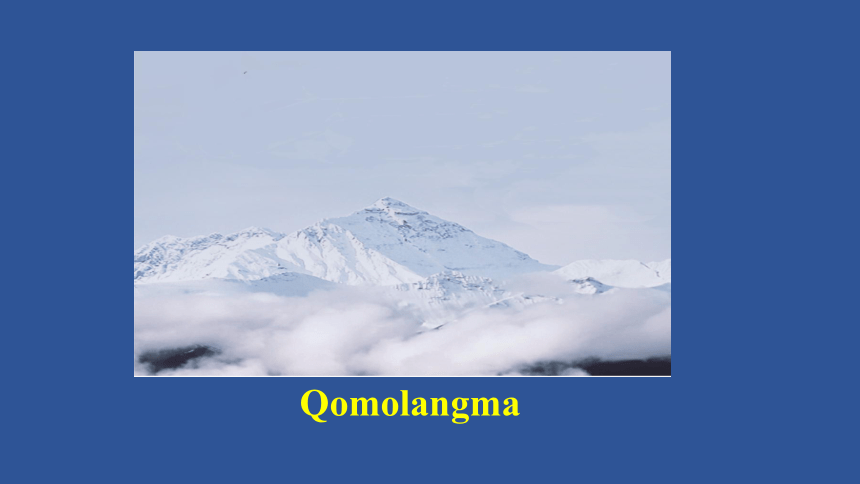
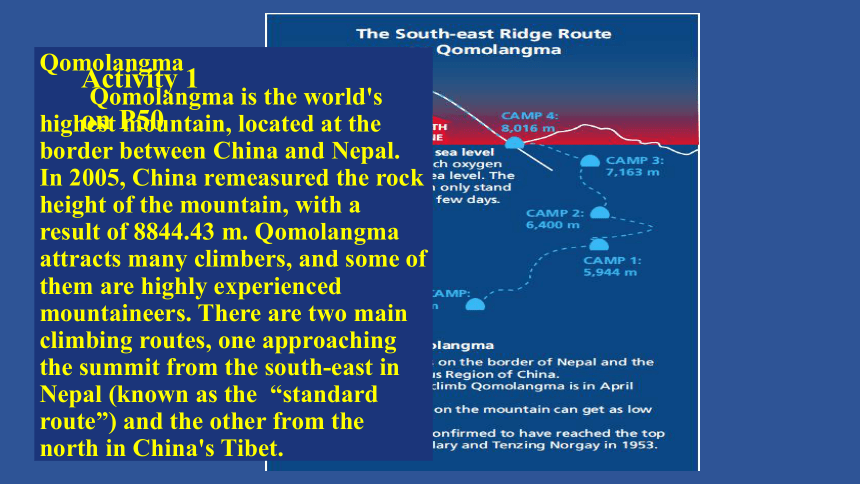
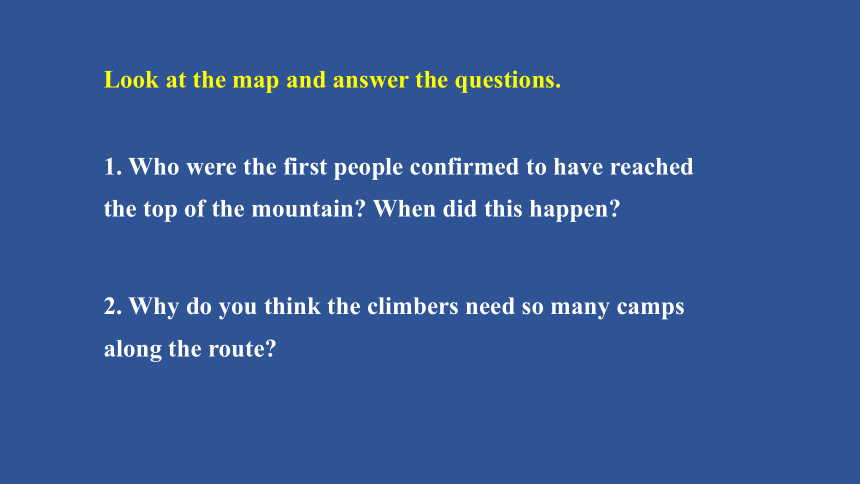
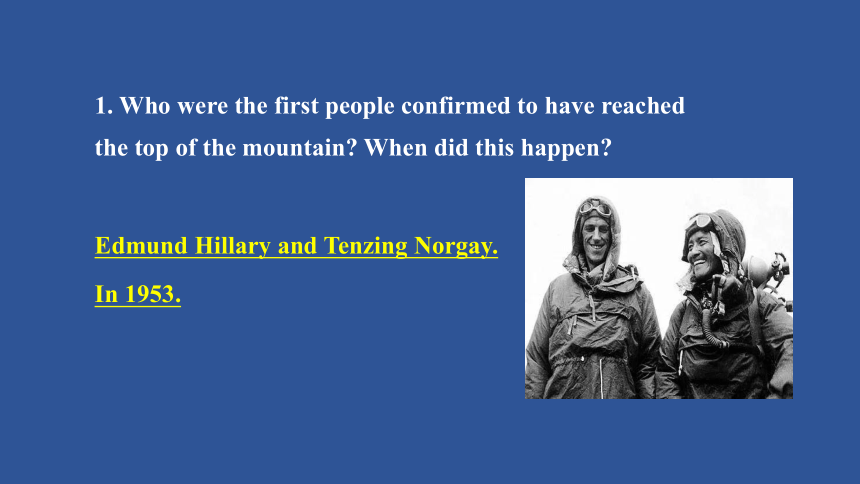
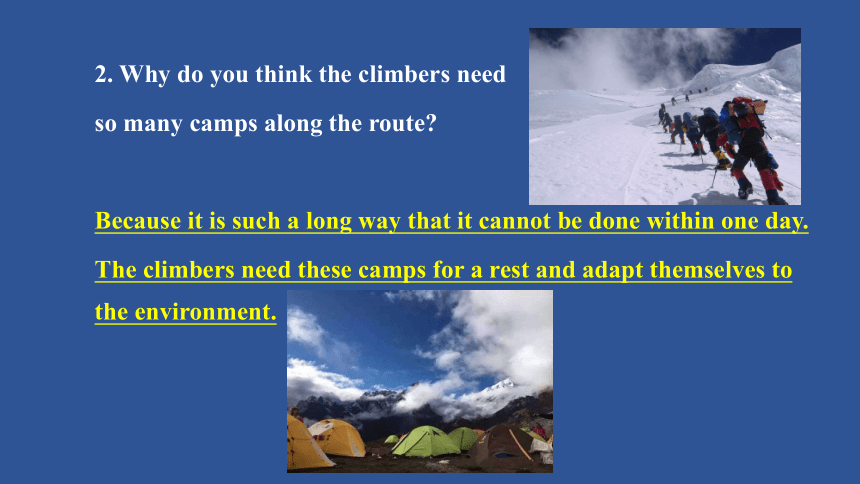
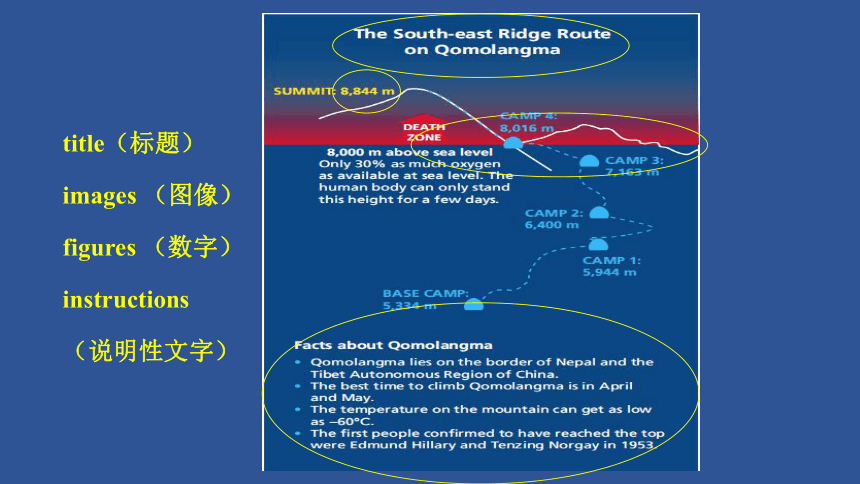

文档简介
(共50张PPT)
第三册
第5单元
Understanding
ideas
高一年级
英语
一、内容介绍
本文语篇类型是夹叙夹议的专栏文章,围绕单元主题“人与自然”,通过举例和引用几位探险家和心理学家的话,分析探险家的探险“天性”和探险活动的价值。
同学们阅读本文可以了解不同的观点,深入理解单元主题并联系生活,形成自己的观点;通过分析语篇结构,同学们可以学习并掌握与话题相关的语言表达,尝试用思维导图更好地理解语篇。
二、新课导入
Climbers
2019
Which
mountain
are
these
people
climbing
?
Pre-reading
Qomolangma
Qomolangma
Qomolangma
is
the
world's
highest
mountain,
located
at
the
border
between
China
and
Nepal.
In
2005,
China
remeasured
the
rock
height
of
the
mountain,
with
a
result
of
8844.43
m.
Qomolangma
attracts
many
climbers,
and
some
of
them
are
highly
experienced
mountaineers.
There
are
two
main
climbing
routes,
one
approaching
the
summit
from
the
south-east
in
Nepal
(known
as
the
“standard
route”)
and
the
other
from
the
north
in
China's
Tibet.
Activity
1
on
P50
Look
at
the
map
and
answer
the
questions.
1.
Who
were
the
first
people
confirmed
to
have
reached
the
top
of
the
mountain?
When
did
this
happen?
2.
Why
do
you
think
the
climbers
need
so
many
camps
along
the
route?
1.
Who
were
the
first
people
confirmed
to
have
reached
the
top
of
the
mountain?
When
did
this
happen?
Edmund
Hillary
and
Tenzing
Norgay.
In
1953.
2.
Why
do
you
think
the
climbers
need
so
many
camps
along
the
route?
Because
it
is
such
a
long
way
that
it
cannot
be
done
within
one
day.
The
climbers
need
these
camps
for
a
rest
and
adapt
themselves
to
the
environment.
title(标题)
images
(图像)
figures
(数字)
instructions
(说明性文字)
What
else
do
you
know
about
Qomolangma?
Share
the
information
with
your
classmates
and
teachers
after
class.
三、知识学习
Fast
reading
Read
through
the
text
and
answer
the
questions.
1.
What
challenges
do
the
climbers
face?
2.
Why
did
George
Mallory
climb
Qomolangma?
3.
What
are
“Type
T”
personalities
according
to
the
text?
P50-51
1.
What
challenges
do
the
climbers
face?
Severe
weather
such
as
extreme
cold,
low
air
pressure;
becoming
sick
and
other
dangers.
2.
Why
did
George
Mallory
climb
Qomolangma?
He
thought
he
could
enjoy
the
joy
of
life
from
climbing.
3.
What
are
“Type
T”
personalities
according
to
the
text?
The
people
with
“Type
T”
personalities
are
risk-taking
and
thrill-seeking.
Activity
3
Choose
the
author's
purpose
in
writing
passage.
1.
To
encourage
people
to
climb
Qomolangma
if
fully
prepared,
as
risks
bring
many
benefits.
2.
To
remind
people
to
balance
the
benefits
and
risks
before
deciding
to
climb
Qomolangma.
3.
To
suggest
that
people
stop
taking
risks
and
climbing
Qomolangma,
as
the
risks
outweigh
the
benefits.
2
To
stop
people
V.
大于;超过
Your
choice:
__________.
×
×
Para
7
With
this
in
mind,
are
the
benefits
of
climbing
Qomolangma
worth
the
risks?
It's
totally
up
to
you.
Let's
locate
the
answers!
1.
What
challenges
do
the
climbers
face?
2.
Why
did
George
Mallory
climb
Qomolangma?
3.
What
are
“Type
T”
personalities
according
to
the
text?
The
author's
purpose
in
writing
the
passage
Para
7
Para
4-5
Para
2
Para
1
details
introduction
conclusion
The
structure
of
the
passage
Part
1
(Para
1)
Part
2
(Para
2-6)
Part
3
(Para
7)
Details
Careful
reading
Activity
4
Complete
the
paragraphs
with
expressions
from
the
passage.
(On
P52)
Why
do
people
climb
Qomolangma?
George
Mallory
What
people
get
from
this
adventure
is
just
1
People
eat
and
make
money
to
be
able
to
2
not
the
other
way
round.
Alan
Arnette
Each
person
has
a(n)
3
reason
for
climbing
a
mountain.
It
forces
people
to
4
themselves.
To
succeed,
people
must
have
the
physical
as
well
as
5
sheer
joy.
enjoy
life,
important
and
unique
look
deep
inside
mental
toughness
.
pure
or
complete
joy
Careful
reading
Scientific
reasons
Risk-taking
may
be
part
of
6
People
who
are
more
likely
to
7
have
“Type
T”
personalities.
Research
also
suggests
that
our
desire
to
seek
risks
can
be
connected
to
how
much
we
expect
to
8
human
nature.
take
risks
benefit
from
the
result.
Careful
reading
Let's
draw
a
mind
map
of
the
text
organization.
四、讲练结合
Please
retell
the
essay
according
to
the
mind
map.
A
possible
version
Climbing
Qomolangma
is
a
special
experience
in
which
the
climbers
may
face
many
challenges
or
even
dangers.
Yet,
despite
this,
most
climbers
still
think
the
climbing
is
worth
the
risks.
For
them,
there
are
several
reasons.
Here
are
some
subjective
reasons.
A
British
mountain
climber
George
Mallory
thought
the
climbing
brought
him
pure
joy
and
made
him
enjoy
life.
An
American
mountain
climber
Alan
Arnette
thought
the
climbing
forces
people
to
look
inside
themselves
and
figure
out
if
they
really
have
the
physical
and
mental
toughness.
In
addition,
studies
show
there
are
some
scientific
reasons.
Perhaps
risk-taking
is
part
of
human
nature,
especially
to
those
who
have
“Type
T”
personalities.
Research
also
suggests
that
the
climbers
think
it’s
worth
the
risks
because
of
men's
desire
to
expect
to
benefit
from
the
result.
Finally,
the
author
lets
the
readers
decide
whether
climbing
Qomolangma
is
worth
the
risk.
1.
Last
year,
hundreds
of
people
spent
good
money
on
an
experience
that
they
knew
would
include
crowds,discomfort
and
danger.
过去将来时的用法,表示在过去某个时间点对未来的看法。
“good
money”
means
“an
amount
of
money
that
you
think
is
large”.
e.g.
His
father
paid
good
money
for
the
once-in-a-lifetime
experience
of
walking
the
Inca
Trail(印加古道).
他父亲斥巨资体验了难得的印加古道漫步。
Language
appreciation
Language
appreciation
2.
For
these
people,
climbing
Qomolangma
is
an
experience
like
no
other,
making
some
feel
weak
and
others,
powerful.
We
could
also
say
Climbing
Qomolangma
is
a
unique
experience
for
people
seeking
adventure.
It
is
an
adventure
that
can
make
some
feel
powerless
and
others
feel
powerful.
Language
appreciation
3.
Sadly,
Mallory
would
die
on
the
mountain
in
1924,
although
his
body
would
not
be
found
until
many
years
later.
It
is
still
not
known
if
he
succeeded
in
reaching
the
top
of
Qomolangma
before
it
took
his
life.
过去将来时被动语态的基本形式为
would
be
done;was/
were
going
to
be
done
take
one's
life
:
kill
someone
e.g.
The
Himalayas
have
taken
the
lives
of
countless
mountain
climbers.
喜马拉雅山夺走了无数登山者的生命。
Language
appreciation
4.
It
brings
into
focus
what's
important
to
you.
If
you
bring
something
into
focus,
people
start
to
talk
about
it
and
pay
attention
to
it.
e.g.
People
have
recently
brought
these
issues
into
focus.
人们最近关注这些热门话题。
Language
appreciation
5.
There
are
a
thousand
reasons
to
turn
around
and
only
one
to
keep
going.
You
really
have
to
focus
on
the
one
reason
that’s
most
important
and
unique
to
you.
It
forces
you
to
look
deep
inside
yourself
and
figure
out
if
you
really
have
the
physical,
as
well
as
mental,
toughness
to
push
when
you
want
to
stop.
We
could
also
say
During
the
climb,
you
may
find
many
excuses
to
stop
and
turn
back.
You
must
think
about
the
most
significant
reason
why
you
want
to
continue.
It
makes
you
look
deep
inside
yourself
and
decide
whether
you're
strong
and
determined
enough
in
both
body
and
mind
to
keep
going.
Language
appreciation
5.
There
are
a
thousand
reasons
to
turn
around
and
only
one
to
keep
going.
You
really
have
to
focus
on
the
one
reason
that’s
most
important
and
unique
to
you.
It
forces
you
to
look
deep
inside
yourself
and
figure
out
if
you
really
have
the
physical,
as
well
as
mental,
toughness
to
push
when
you
want
to
stop.
figure
out:understand
the
meaning
of
...(明白、弄懂、理解)
e.g.
We
had
to
figure
out
the
connection
between
the
two
events.
我们要弄懂这两件事之间的联系。
It
took
me
a
while
to
figure
out
what
happened.
过了好一会儿我才明白发生了什么。
Language
appreciation
5.
There
are
a
thousand
reasons
to
turn
around
and
only
one
to
keep
going.
You
really
have
to
focus
on
the
one
reason
that’s
most
important
and
unique
to
you.
It
forces
you
to
look
deep
inside
yourself
and
figure
out
if
you
really
have
the
physical,
as
well
as
mental,
toughness
to
push
when
you
want
to
stop.
figure
out:work
out
or
find
the
answer
to
something
or
solution
to
a
problem
by
thinking
carefully
about
it.
e.g.
It
would
be
difficult
to
figure
out
the
losses
at
this
time.
现在还很难计算出有多少损失。
Language
appreciation
6.
With
the
majority
of
attempts
to
climb
Qomolangma
resulting
either
in
total
success
or
failure,
is
there
also
a
scientific
reason
behind
this
risk-taking?
We
could
also
say
Many
people
try
to
climb
Qomolangma
and
either
they
make
it
or
they
don't.
Why
is
it
that
they
risk
their
lives
in
this
way?
Is
there
a
scientific
reason
for
doing
so?
Language
appreciation
7.
He
refers
to
the
personalities
of
these
people
as
“Type
T”,
with
T
standing
for
“thrill”.
refer
to
...
as...:
称呼……为……,把……称作……
e.g.
He
likes
to
be
referred
to
as
“Doctor
Lee”.
他愿意被称呼为李博士。
天津之眼被称为城市新地标。
The
Tianjin
Eye
is
referred
to
as
a
new
landmark
of
this
city.
8.
Research
also
suggests
that
our
desire
to
seek
risks
can
be
connected
to
how
much
we
expect
to
benefit
from
the
result.
Research
suggests
that...
:研究表明(显示)……
be
connected
to
=
be
connected
with/
be
related
to
与…有关(相联系)。
Language
appreciation
While
reading,
we
should
try
to
appreciate
some
good
expressions
and
sentences,
which
may
help
us
to
vary,
enrich
and
improve
our
writing.
So
please
remember
to
put
what
we
learned
in
class
into
practice
in
your
English
study.
五、实践应用
Think
&
Share
1.
Do
you
agree
with
Mallory’s
and
Arnette’s
opinions?
Why
or
why
not?
Yes.
Because
I
believe
exploration
is
not
only
an
exploration
of
nature
and
the
unknown
world,
but
also
a
challenge
to
oneself.
That's
a
good
chance
to
get
improved.
So
I
think
if
I
am
fully
prepared,
the
benefits
and
joy
the
exploration
brings
to
me
outweigh
the
risks.
Think
&
Share
2.
If
you
were
given
the
chance,
would
you
like
to
climb
Qomolangma?
Why
or
why
not?
Personally,
I
am
willing
to
meet
the
challenge.
On
the
one
hand,
anyone
standing
at
the
highest
point
of
the
world
is
seen
as
a
winner
in?physical
and
mental
aspects.
On
the
other
hand,
I
think
I
will
get
a
lot
from
this
adventure,
including
the
courage
to
overcome
any
difficulty,
the
sense
of
great
achievement
as
well
as
the
joy
of
life.
So
it's
worth
the
risks.
To
read
a
map.
To
get
some
details
and
draw
a
mind
map.
To
further
understand
and
appreciate
expressions
and
sentences.
What
we’ve
learned
in
this
class
六、课后作业
Homework
1.
Summarize
the
passage
according
to
the
mind
map.
2.
Surf
the
Internet
to
find
more
information
about
Qomolangma.
七、结束语
When
faced
with
difficulties
and
even
dangers,
climbers
and
explorers
never
give
up.
They
are
willing
to
take
the
risks
and
the
challenges
with
great
courage.
That's
the
spirit
of
exploration.
As
a
saying
goes,
a
man
who
remains
childlike
curiosity,
and
makes
all
efforts
to
explore
the
unknown
fields
would
always
feel
the
fullness
of
life
and
joy.
Let's
keep
the
spirit
of
exploration.
Thanks!
第三册
第5单元
Understanding
ideas
高一年级
英语
一、内容介绍
本文语篇类型是夹叙夹议的专栏文章,围绕单元主题“人与自然”,通过举例和引用几位探险家和心理学家的话,分析探险家的探险“天性”和探险活动的价值。
同学们阅读本文可以了解不同的观点,深入理解单元主题并联系生活,形成自己的观点;通过分析语篇结构,同学们可以学习并掌握与话题相关的语言表达,尝试用思维导图更好地理解语篇。
二、新课导入
Climbers
2019
Which
mountain
are
these
people
climbing
?
Pre-reading
Qomolangma
Qomolangma
Qomolangma
is
the
world's
highest
mountain,
located
at
the
border
between
China
and
Nepal.
In
2005,
China
remeasured
the
rock
height
of
the
mountain,
with
a
result
of
8844.43
m.
Qomolangma
attracts
many
climbers,
and
some
of
them
are
highly
experienced
mountaineers.
There
are
two
main
climbing
routes,
one
approaching
the
summit
from
the
south-east
in
Nepal
(known
as
the
“standard
route”)
and
the
other
from
the
north
in
China's
Tibet.
Activity
1
on
P50
Look
at
the
map
and
answer
the
questions.
1.
Who
were
the
first
people
confirmed
to
have
reached
the
top
of
the
mountain?
When
did
this
happen?
2.
Why
do
you
think
the
climbers
need
so
many
camps
along
the
route?
1.
Who
were
the
first
people
confirmed
to
have
reached
the
top
of
the
mountain?
When
did
this
happen?
Edmund
Hillary
and
Tenzing
Norgay.
In
1953.
2.
Why
do
you
think
the
climbers
need
so
many
camps
along
the
route?
Because
it
is
such
a
long
way
that
it
cannot
be
done
within
one
day.
The
climbers
need
these
camps
for
a
rest
and
adapt
themselves
to
the
environment.
title(标题)
images
(图像)
figures
(数字)
instructions
(说明性文字)
What
else
do
you
know
about
Qomolangma?
Share
the
information
with
your
classmates
and
teachers
after
class.
三、知识学习
Fast
reading
Read
through
the
text
and
answer
the
questions.
1.
What
challenges
do
the
climbers
face?
2.
Why
did
George
Mallory
climb
Qomolangma?
3.
What
are
“Type
T”
personalities
according
to
the
text?
P50-51
1.
What
challenges
do
the
climbers
face?
Severe
weather
such
as
extreme
cold,
low
air
pressure;
becoming
sick
and
other
dangers.
2.
Why
did
George
Mallory
climb
Qomolangma?
He
thought
he
could
enjoy
the
joy
of
life
from
climbing.
3.
What
are
“Type
T”
personalities
according
to
the
text?
The
people
with
“Type
T”
personalities
are
risk-taking
and
thrill-seeking.
Activity
3
Choose
the
author's
purpose
in
writing
passage.
1.
To
encourage
people
to
climb
Qomolangma
if
fully
prepared,
as
risks
bring
many
benefits.
2.
To
remind
people
to
balance
the
benefits
and
risks
before
deciding
to
climb
Qomolangma.
3.
To
suggest
that
people
stop
taking
risks
and
climbing
Qomolangma,
as
the
risks
outweigh
the
benefits.
2
To
stop
people
V.
大于;超过
Your
choice:
__________.
×
×
Para
7
With
this
in
mind,
are
the
benefits
of
climbing
Qomolangma
worth
the
risks?
It's
totally
up
to
you.
Let's
locate
the
answers!
1.
What
challenges
do
the
climbers
face?
2.
Why
did
George
Mallory
climb
Qomolangma?
3.
What
are
“Type
T”
personalities
according
to
the
text?
The
author's
purpose
in
writing
the
passage
Para
7
Para
4-5
Para
2
Para
1
details
introduction
conclusion
The
structure
of
the
passage
Part
1
(Para
1)
Part
2
(Para
2-6)
Part
3
(Para
7)
Details
Careful
reading
Activity
4
Complete
the
paragraphs
with
expressions
from
the
passage.
(On
P52)
Why
do
people
climb
Qomolangma?
George
Mallory
What
people
get
from
this
adventure
is
just
1
People
eat
and
make
money
to
be
able
to
2
not
the
other
way
round.
Alan
Arnette
Each
person
has
a(n)
3
reason
for
climbing
a
mountain.
It
forces
people
to
4
themselves.
To
succeed,
people
must
have
the
physical
as
well
as
5
sheer
joy.
enjoy
life,
important
and
unique
look
deep
inside
mental
toughness
.
pure
or
complete
joy
Careful
reading
Scientific
reasons
Risk-taking
may
be
part
of
6
People
who
are
more
likely
to
7
have
“Type
T”
personalities.
Research
also
suggests
that
our
desire
to
seek
risks
can
be
connected
to
how
much
we
expect
to
8
human
nature.
take
risks
benefit
from
the
result.
Careful
reading
Let's
draw
a
mind
map
of
the
text
organization.
四、讲练结合
Please
retell
the
essay
according
to
the
mind
map.
A
possible
version
Climbing
Qomolangma
is
a
special
experience
in
which
the
climbers
may
face
many
challenges
or
even
dangers.
Yet,
despite
this,
most
climbers
still
think
the
climbing
is
worth
the
risks.
For
them,
there
are
several
reasons.
Here
are
some
subjective
reasons.
A
British
mountain
climber
George
Mallory
thought
the
climbing
brought
him
pure
joy
and
made
him
enjoy
life.
An
American
mountain
climber
Alan
Arnette
thought
the
climbing
forces
people
to
look
inside
themselves
and
figure
out
if
they
really
have
the
physical
and
mental
toughness.
In
addition,
studies
show
there
are
some
scientific
reasons.
Perhaps
risk-taking
is
part
of
human
nature,
especially
to
those
who
have
“Type
T”
personalities.
Research
also
suggests
that
the
climbers
think
it’s
worth
the
risks
because
of
men's
desire
to
expect
to
benefit
from
the
result.
Finally,
the
author
lets
the
readers
decide
whether
climbing
Qomolangma
is
worth
the
risk.
1.
Last
year,
hundreds
of
people
spent
good
money
on
an
experience
that
they
knew
would
include
crowds,discomfort
and
danger.
过去将来时的用法,表示在过去某个时间点对未来的看法。
“good
money”
means
“an
amount
of
money
that
you
think
is
large”.
e.g.
His
father
paid
good
money
for
the
once-in-a-lifetime
experience
of
walking
the
Inca
Trail(印加古道).
他父亲斥巨资体验了难得的印加古道漫步。
Language
appreciation
Language
appreciation
2.
For
these
people,
climbing
Qomolangma
is
an
experience
like
no
other,
making
some
feel
weak
and
others,
powerful.
We
could
also
say
Climbing
Qomolangma
is
a
unique
experience
for
people
seeking
adventure.
It
is
an
adventure
that
can
make
some
feel
powerless
and
others
feel
powerful.
Language
appreciation
3.
Sadly,
Mallory
would
die
on
the
mountain
in
1924,
although
his
body
would
not
be
found
until
many
years
later.
It
is
still
not
known
if
he
succeeded
in
reaching
the
top
of
Qomolangma
before
it
took
his
life.
过去将来时被动语态的基本形式为
would
be
done;was/
were
going
to
be
done
take
one's
life
:
kill
someone
e.g.
The
Himalayas
have
taken
the
lives
of
countless
mountain
climbers.
喜马拉雅山夺走了无数登山者的生命。
Language
appreciation
4.
It
brings
into
focus
what's
important
to
you.
If
you
bring
something
into
focus,
people
start
to
talk
about
it
and
pay
attention
to
it.
e.g.
People
have
recently
brought
these
issues
into
focus.
人们最近关注这些热门话题。
Language
appreciation
5.
There
are
a
thousand
reasons
to
turn
around
and
only
one
to
keep
going.
You
really
have
to
focus
on
the
one
reason
that’s
most
important
and
unique
to
you.
It
forces
you
to
look
deep
inside
yourself
and
figure
out
if
you
really
have
the
physical,
as
well
as
mental,
toughness
to
push
when
you
want
to
stop.
We
could
also
say
During
the
climb,
you
may
find
many
excuses
to
stop
and
turn
back.
You
must
think
about
the
most
significant
reason
why
you
want
to
continue.
It
makes
you
look
deep
inside
yourself
and
decide
whether
you're
strong
and
determined
enough
in
both
body
and
mind
to
keep
going.
Language
appreciation
5.
There
are
a
thousand
reasons
to
turn
around
and
only
one
to
keep
going.
You
really
have
to
focus
on
the
one
reason
that’s
most
important
and
unique
to
you.
It
forces
you
to
look
deep
inside
yourself
and
figure
out
if
you
really
have
the
physical,
as
well
as
mental,
toughness
to
push
when
you
want
to
stop.
figure
out:understand
the
meaning
of
...(明白、弄懂、理解)
e.g.
We
had
to
figure
out
the
connection
between
the
two
events.
我们要弄懂这两件事之间的联系。
It
took
me
a
while
to
figure
out
what
happened.
过了好一会儿我才明白发生了什么。
Language
appreciation
5.
There
are
a
thousand
reasons
to
turn
around
and
only
one
to
keep
going.
You
really
have
to
focus
on
the
one
reason
that’s
most
important
and
unique
to
you.
It
forces
you
to
look
deep
inside
yourself
and
figure
out
if
you
really
have
the
physical,
as
well
as
mental,
toughness
to
push
when
you
want
to
stop.
figure
out:work
out
or
find
the
answer
to
something
or
solution
to
a
problem
by
thinking
carefully
about
it.
e.g.
It
would
be
difficult
to
figure
out
the
losses
at
this
time.
现在还很难计算出有多少损失。
Language
appreciation
6.
With
the
majority
of
attempts
to
climb
Qomolangma
resulting
either
in
total
success
or
failure,
is
there
also
a
scientific
reason
behind
this
risk-taking?
We
could
also
say
Many
people
try
to
climb
Qomolangma
and
either
they
make
it
or
they
don't.
Why
is
it
that
they
risk
their
lives
in
this
way?
Is
there
a
scientific
reason
for
doing
so?
Language
appreciation
7.
He
refers
to
the
personalities
of
these
people
as
“Type
T”,
with
T
standing
for
“thrill”.
refer
to
...
as...:
称呼……为……,把……称作……
e.g.
He
likes
to
be
referred
to
as
“Doctor
Lee”.
他愿意被称呼为李博士。
天津之眼被称为城市新地标。
The
Tianjin
Eye
is
referred
to
as
a
new
landmark
of
this
city.
8.
Research
also
suggests
that
our
desire
to
seek
risks
can
be
connected
to
how
much
we
expect
to
benefit
from
the
result.
Research
suggests
that...
:研究表明(显示)……
be
connected
to
=
be
connected
with/
be
related
to
与…有关(相联系)。
Language
appreciation
While
reading,
we
should
try
to
appreciate
some
good
expressions
and
sentences,
which
may
help
us
to
vary,
enrich
and
improve
our
writing.
So
please
remember
to
put
what
we
learned
in
class
into
practice
in
your
English
study.
五、实践应用
Think
&
Share
1.
Do
you
agree
with
Mallory’s
and
Arnette’s
opinions?
Why
or
why
not?
Yes.
Because
I
believe
exploration
is
not
only
an
exploration
of
nature
and
the
unknown
world,
but
also
a
challenge
to
oneself.
That's
a
good
chance
to
get
improved.
So
I
think
if
I
am
fully
prepared,
the
benefits
and
joy
the
exploration
brings
to
me
outweigh
the
risks.
Think
&
Share
2.
If
you
were
given
the
chance,
would
you
like
to
climb
Qomolangma?
Why
or
why
not?
Personally,
I
am
willing
to
meet
the
challenge.
On
the
one
hand,
anyone
standing
at
the
highest
point
of
the
world
is
seen
as
a
winner
in?physical
and
mental
aspects.
On
the
other
hand,
I
think
I
will
get
a
lot
from
this
adventure,
including
the
courage
to
overcome
any
difficulty,
the
sense
of
great
achievement
as
well
as
the
joy
of
life.
So
it's
worth
the
risks.
To
read
a
map.
To
get
some
details
and
draw
a
mind
map.
To
further
understand
and
appreciate
expressions
and
sentences.
What
we’ve
learned
in
this
class
六、课后作业
Homework
1.
Summarize
the
passage
according
to
the
mind
map.
2.
Surf
the
Internet
to
find
more
information
about
Qomolangma.
七、结束语
When
faced
with
difficulties
and
even
dangers,
climbers
and
explorers
never
give
up.
They
are
willing
to
take
the
risks
and
the
challenges
with
great
courage.
That's
the
spirit
of
exploration.
As
a
saying
goes,
a
man
who
remains
childlike
curiosity,
and
makes
all
efforts
to
explore
the
unknown
fields
would
always
feel
the
fullness
of
life
and
joy.
Let's
keep
the
spirit
of
exploration.
Thanks!
